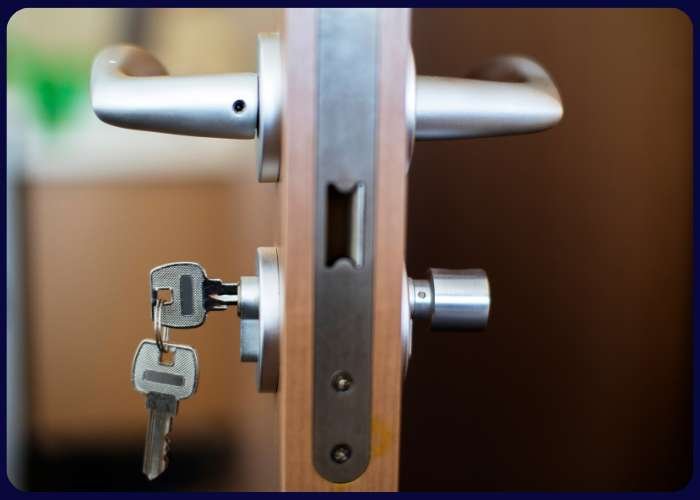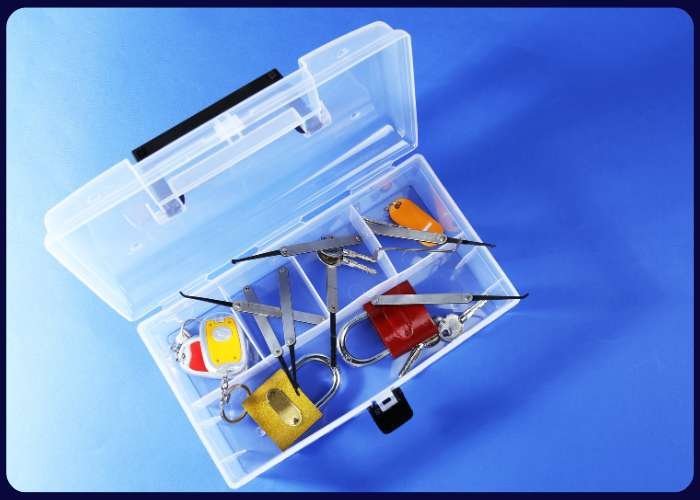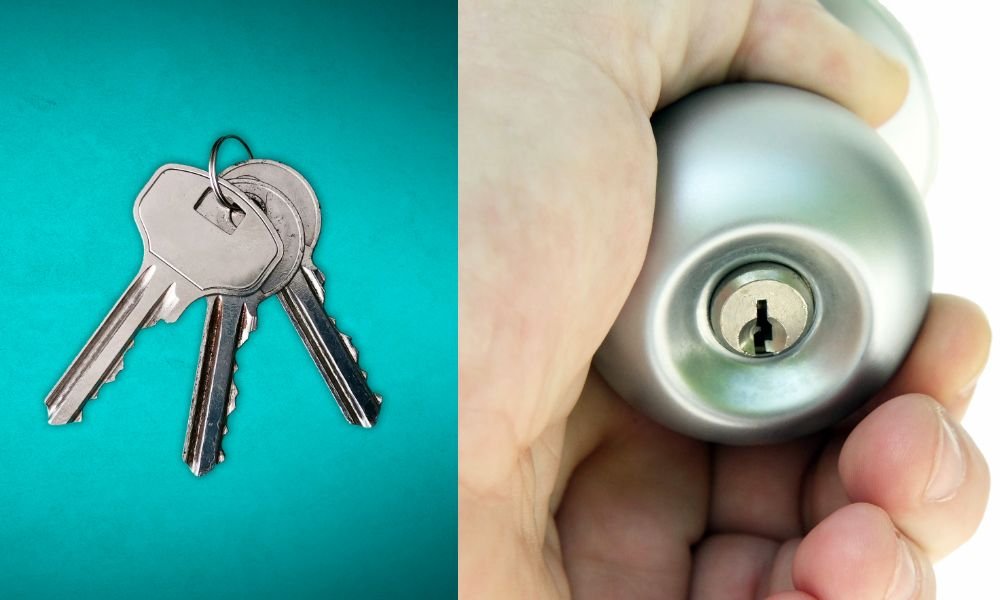Lock-picking is a skill that can save you from frustrating situations, like being locked out of your home. Without professional tools, it’s still possible to open many locks using everyday items, patience, and a basic understanding of lock mechanisms. This guide provides detailed steps, suitable tools, and important ethical considerations for picking locks without tools. Let’s dive into how to pick a lock without tools such as emergencies responsibly and legally.
1. Understanding the Basics of Locks
To successfully pick a lock, you must understand how it functions. Most locks operate using a pin-and-tumbler mechanism. Inside, spring-loaded pins rest at varying heights. A key aligns these pins perfectly, allowing the cylinder to rotate and open the device. When picking a security device, you mimic the key’s action by lifting the pins manually and applying rotational tension to the cylinder. Knowing this structure helps you manipulate the mechanism effectively.
A. Anatomy of a Lock

A typical lock includes the cylinder, pins, springs, and plug. The cylinder holds the pins and rotates only when the pins align at the “shear line.” This alignment occurs naturally when the correct key is used. In bypassing securing systems, your goal is to simulate this alignment using improvised tools, like hairpins or paper clips. Understanding these parts allows you to identify where and how to apply pressure while picking a device.
B. Key Principles of Lock Picking
The key principle in bypassing securing systems is applying tension while manipulating pins. This combination allows you to simulate the natural movement of a key. Tension keeps pins from resetting, while picking adjusts their height to reach the shear line. Precision is vital—too much tension can damage the device or tools, while too little may fail to hold the pins in place. Mastering this balance ensures effective picking of security devices.
2. Everyday Objects for Lock Picking
Picking a security device doesn’t always require specialized tools. Common household items can often work just as well when used creatively. By adapting items like hairpins, paper clips, or small screwdrivers, you can replicate the function of professional device picks and tension wrenches. The versatility of these objects makes them ideal for emergency situations. However, ensure the objects are sturdy enough to avoid breaking inside the lock, which could complicate the situation further.
A. Hairpins and Bobby Pins
Hairpins are among the most accessible and effective tools for lock picking. Bend one into an “L” shape to act as a tension wrench, and use another as a makeshift pick. Insert the tension tool into the lock’s base and apply slight pressure. Then, use the pick to manipulate each pin until you feel or hear a click, indicating alignment. Hairpins are lightweight and easy to carry, making them perfect for emergencies.
B. Paper Clips
Paper clips are another great option for improvising lock picking tools. Straighten one clip to create a pick and bend another into a tension wrench. These metal objects are malleable yet sturdy, allowing you to push and lift pins effectively. Insert the tension tool first and follow the same process of pin manipulation. Paper clips are particularly useful because they are common and can be modified quickly to suit your needs.
C. Small Screwdrivers
If available, small flat-head screwdrivers can act as reliable tension tools. These are especially effective for larger locks where hairpins or paper clips might not be strong enough. Combine the screwdriver with another improvised pick, like a paper clip, to push pins into place. Ensure you use light, controlled pressure to avoid damaging the device mechanism or breaking the improvised tools inside it.
3. Step-by-Step Lock Picking Process
Lock picking requires a systematic approach to align the pins and rotate the cylinder. Follow these steps to increase your success. Start by inserting your tension tool into the bottom of the device. Apply gentle rotational pressure while keeping it steady. Next, use your improvised pick to push each pin upward. When all pins align correctly, the device will rotate, and you’ll be able to open it.
A. Insert a Tension Tool
The first step is inserting a tension tool, such as a bent hairpin or small screwdriver, into the bottom of the lock’s keyway. This tool applies the rotational pressure needed to simulate the key’s turning motion. Ensure the tool fits snugly and maintain light, consistent pressure. Avoid using excessive force, as this can damage the lock’s internal components or break your tool, making the situation harder to resolve.
B. Manipulate the Pins
Once the tension tool is in place, use a second improvised tool, like a straightened paper clip, to manipulate the pins. Insert the pick into the keyway and push each pin upward, one by one. Listen for subtle clicks or feel for slight resistance changes, which indicate proper alignment. Repeat this process until all pins reach the shear line. Be patient and methodical, as rushing can reset your progress.
C. Rotate the Cylinder
After aligning all the pins, gently rotate the cylinder using the tension tool. If the lock doesn’t turn, reassess the pin alignment and adjust your tension. Success depends on maintaining steady pressure throughout the process. Once the cylinder rotates, the device will open. Always handle the mechanism with care to avoid damaging it, especially if you plan to continue using the lock.
4. Practicing Lock Picking Techniques

Pick a security device is a skill that improves with practice. Start by familiarizing yourself with simple locks, such as padlocks, before progressing to more complex mechanisms. Using practice security device kits can also help you develop the necessary precision and confidence. These kits often feature transparent locks that allow you to observe pin movements, making it easier to understand the process. Regular practice ensures you’re prepared for emergencies without damaging the latch.
5. Legal and Ethical Considerations
Understanding the legal and ethical implications is essential. This task is legal only when you have permission to access the lock, such as when it’s your property or you’ve been authorized by the owner. Misusing these skills for unlawful purposes can lead to serious consequences. Always respect others’ property and privacy, and use lock-picking skills solely for legitimate reasons, such as emergency access to your own belongings.
A. Ensure Legal Compliance
Lock picking laws vary by location, but it is generally legal to pick locks you own. However, possessing lock-picking tools without a valid reason may be restricted in some regions. Familiarize yourself with the local regulations to avoid legal problems. Practicing on locks you don’t own, even without malicious intent, can lead to accusations of trespassing or vandalism. Always prioritize lawful and responsible use of lock-picking skills.
B. Respect Ethical Boundaries
Ethical considerations are equally crucial as legal compliance. This attempt should never be used to invade someone’s privacy or property. Misusing this skill not only breaches trust but can also harm your reputation and relationships. Always seek permission before attempting to pick a security device that isn’t yours. Respecting ethical boundaries ensures that your lock-picking skills are viewed as a responsible and valuable resource in emergencies.
6. Safety Measures and Precautions
Safety is paramount when picking a device without tools. Always handle the lock mechanism with care to avoid damaging it or your tools. Improvised tools can sometimes break inside the device, making the situation worse. If you’re unable to open the security device after several attempts, consider calling a professional locksmith to prevent further complications. Taking precautionary measures ensures that your lock-picking attempts are safe, efficient, and minimize the risk of damage.
A. Avoid Excessive Force

Using too much pressure can damage the device or break your tools inside it, making it harder to resolve the issue. Always use gentle and controlled movements while manipulating pins and applying tension. If the lock doesn’t open after several attempts, reassess your technique rather than increasing force. Patience is key to successful works and prevents unnecessary damage to your property or improvised tools.
B. Have a Backup Plan
If fails, have a backup plan in place. Keep spare keys in a secure location, such as with a trusted neighbour or inside a lockbox. Alternatively, consider investing in keyless entry systems to avoid future lockout situations. Knowing when to call a professional locksmith is also essential, especially if you’re dealing with a high-security device or an urgent situation that requires immediate access.
7. Alternative Solutions to Lock Picking
When security device picking isn’t an option, alternative solutions can help you regain access. Keyless entry systems, spare key management, or calling a locksmith are effective ways to address lockouts. These options are especially useful for high-security locks that are resistant to picking. Investing in preventive measures, such as duplicate keys or advanced security systems, reduces the likelihood of needing to pick a lock in the first place.
Conclusion

Lock picking without tools is a valuable skill for emergencies, but it requires patience, creativity, and responsibility. By understanding the mechanism, practising with improvised tools, and adhering to legal and ethical standards, you can effectively handle lockouts without damaging the lock or compromising your integrity. Remember, this skill should be used only for lawful purposes, such as accessing your property or assisting with permission. Stay prepared, and always act responsibly.



